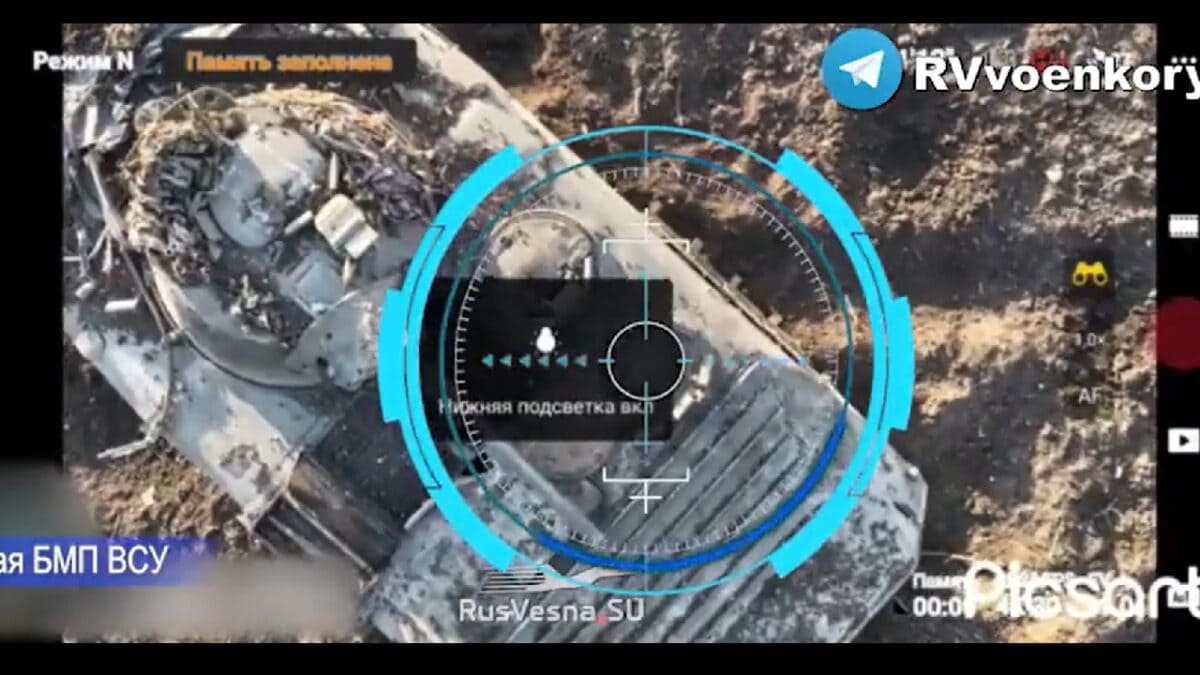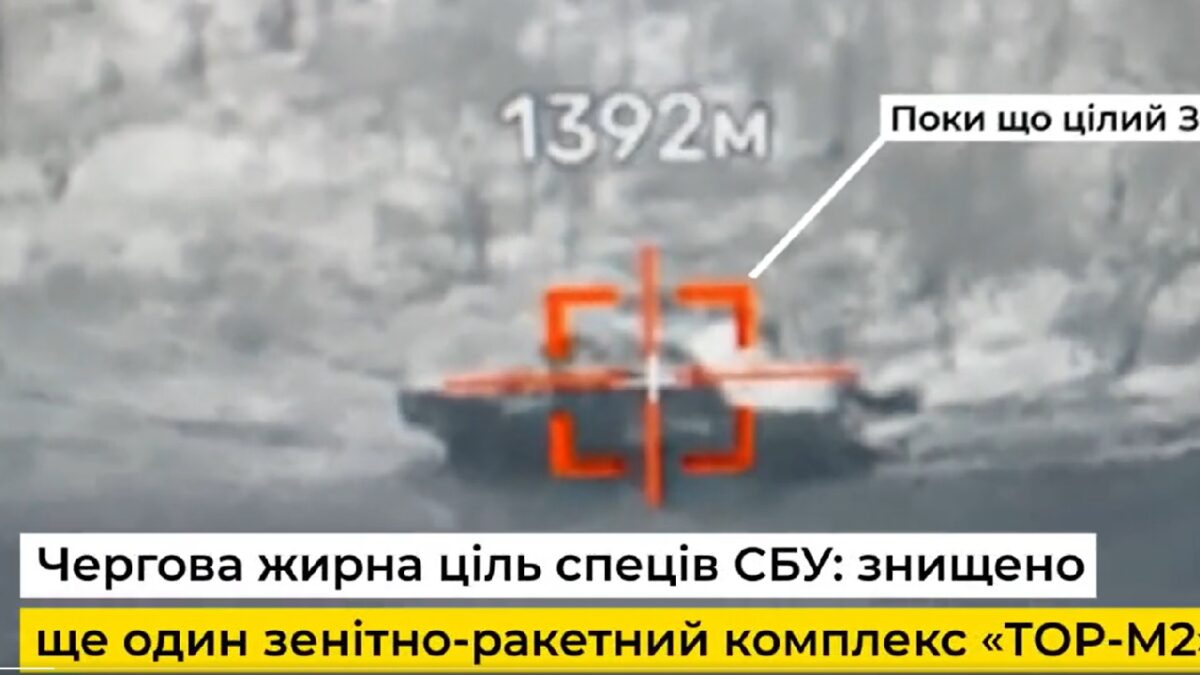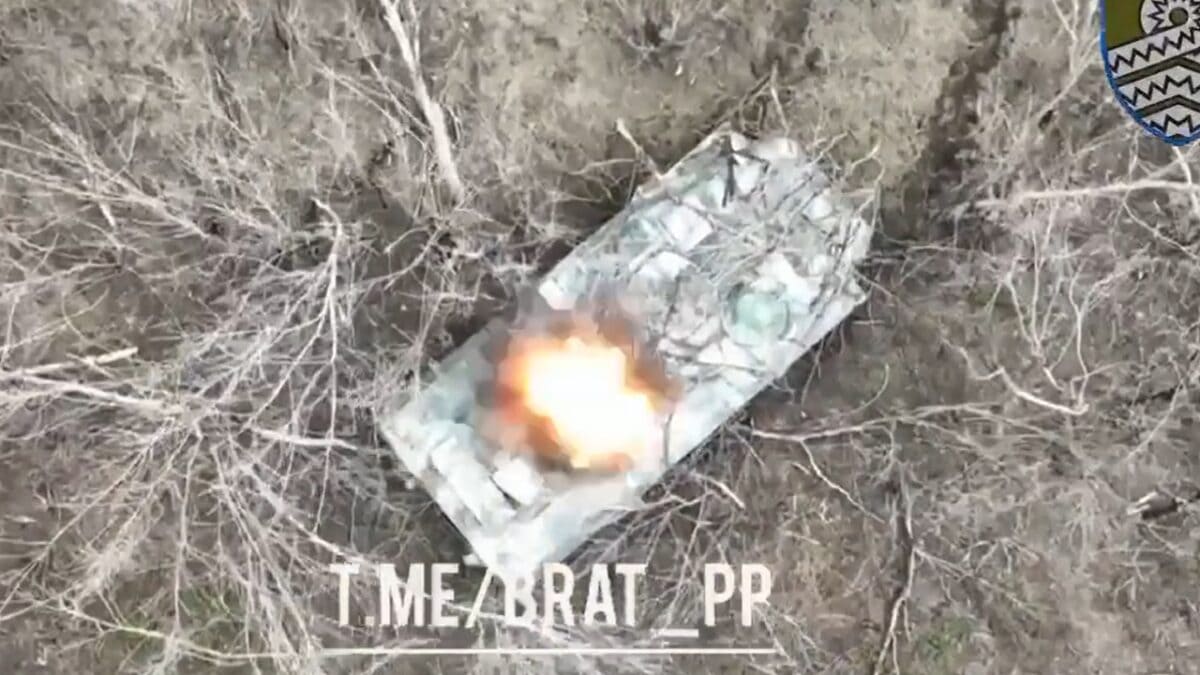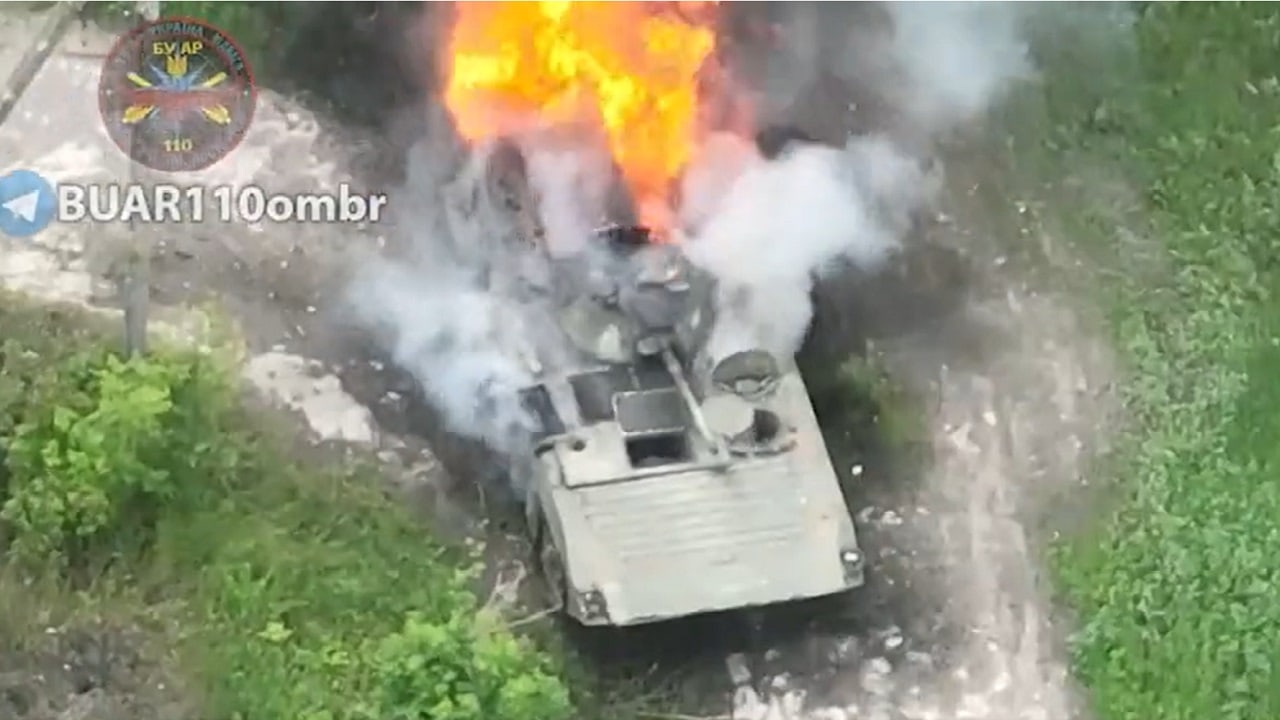In August 2014, several months after Russia invaded eastern Ukraine for the first time, a team of students and engineers from Kyiv’s Step IT Academy gathered at a downtown athletic field to showcase their novel contribution to the war effort. While curious joggers trotted past, one student set up an antenna, and Ivan Dovgal, head of the IT Academy’s robotics lab, ran pre-flight checks on a small quadcopter drone modified for battlefield surveillance. Shortly thereafter, a Ukrainian special operations team arrived.
After a brief round of handshakes, Dovgal’s team launched into their lesson, explaining how to control the drone using an iPad app. When it was time for some hands-on training, they patiently guided each commando through takeoff, a few basic maneuvers, and a gentle landing. They also showed the soldiers how to use the drone’s camera to scout for enemy positions.
Once the test flights were done, one bearded special operator smiled, slapped Dovgal on the shoulder and said, “Now we need to put grenades on these things.”
Soldiers of Soldering Iron
Frustrated by Kyiv’s lukewarm interest in unmanned technologies at the time, Dovgal tapped into the technical know-how and creativity of his students to launch a crowdfunded drone assembly and training program. They called themselves the “soldiers of soldering iron.” Operating from their university’s workshop, Dovgal’s team worked at a frenetic pace, transforming commercially available DJI Phantom drones into tactical surveillance systems. At a price tag of about $2,300, each modified drone carried a Sony A-7 video camera, allowing troops to remotely observe enemy positions without exposing themselves to ambush. Dovgal frequently traveled to the frontlines to teach soldiers how to operate the drones.
“Our priority now is getting drones in the field,” Dovgal told this correspondent at the time.
Dovgal and his “soldiers of soldering iron” belonged to a generation of technologically savvy Ukrainian volunteers who launched grassroots programs to build drones and train operators when the war began in 2014. By the time Russia fully invaded in February 2022, Ukrainian volunteers had acquired nearly a decade of experience in jury-rigging commercial, off-the-shelf drones for a wide range of combat roles, including aerial reconnaissance, artillery spotting, and dropping small munitions. Kyiv ultimately warmed to the importance of drones, and Ukrainian defense firms and start-ups have developed a number of drones for military applications.
The Russian military also began adapting small drones for surveillance and strike missions long before February 2022. Prior to Russia’s full-scale invasion, the static, stalemated war in the Donbas became a training ground for some of Russia’s newest combat technologies, including small drones. Resultantly, Ukrainian troops learned to live under the constant specter of threats from above. They avoided gathering outside, especially in clear weather, and took pains to camouflage their trenches and dugouts from aerial reconnaissance.
“It puts you under constant pressure when you always expect something from the air. It’s very hard to fight against it,” a Ukrainian first lieutenant named Illia told me during an interview on the frontlines of the Donbas in October 2021.
A New Era
Now, some 17 months after Russia’s full invasion, the use of expendable, unmanned systems on Ukraine’s battlefields has exponentially expanded on both sides, replacing many roles previously held by manned aircraft and more expensive unmanned platforms.
Ukrainian forces have conducted dozens of long-distance drone strikes on Russian territory and within occupied Crimea. Ukrainian drones have rammed Russian drones over the battlefield, providing some of the first true instances of drone-on-drone warfare. Russia regularly uses its arsenal of Iran-made, Shahed-136 exploding drones to target Ukrainian cities and critical infrastructure sites, and to cull Ukraine’s air defenses ahead of mass missile attacks.
With the ground war mired in a bloody battle of attrition in which ammunition supplies are a key constraint for both sides, surveillance drones are a potent force multiplier. They offer a relatively inexpensive way to precisely target and correct artillery fire, and thereby limit the number of wasted shots.
“Given that ammo is one of the most constrained assets of this war, where production capacity in the West is often maxed out, making sure that every shell is used as accurately as possible is a very high priority goal. And surveillance drones are accomplishing that goal,” Andrey Liscovich, president of the Ukraine Defense Fund, a charity that supplies non-lethal aid to Ukraine, said during a July 24 interview on the Geopolitics Decanted podcast.
When it comes to drone combat, the war in Ukraine marks a shift away from expensive, standalone platforms in favor of the dispersed, mass-scale use of cheap and expendable systems. And as drones have proliferated on the battlefield, so have counter-drone defenses. There are kinetic options, such as machine guns and surface-to-air missiles. And there are directed energy and electronic warfare systems that interfere with a drone’s electronics. A recent RUSI report, published before Ukraine’s counteroffensive began, stated that Ukraine was losing about 10,000 drones a month. Most experts agree that the Russians are also losing thousands of drones each month.
To stay in the fight, both sides are racing to mass-produce drones and to train operators, then to sustain those numbers over the long haul. What began as a patchwork of grassroots initiatives has since turned into burgeoning military-industrial enterprises in both Russia and Ukraine.
Army of Drones
Under the watch of a visionary, 32-year-old deputy prime minister named Mykhailo Fedorov, Ukraine’s Army of Drones initiative has melded military, government, and civil society efforts to support drone procurement and operator training. This collaborative approach has paid dividends, surging the pace of production and innovation.
Working with 80 domestic drone manufacturers, the Army of Drones initiative plans to acquire some 200,000 drones this year. Those efforts are paying off on the battlefield. In just one week this July, Ukraine’s military said it used the initiative’s drones to destroy 17 Russian tanks, 18 armored personnel carriers, 4 self-propelled artillery systems, and a number of other vehicles and weapons.
Fedorov enacted new policies to streamline government contracts for domestic companies that manufacture first-person-view kamikaze drones, or FPV drones. By eliminating red tape, Fedorov said that Kyiv has so far awarded state contracts to at least 40 Ukrainian private sector FPV drone designs — up from seven one year ago.

Ukraine BMP-1 Attack by Drone
Originally conceived for racing, FPV drones zip around at 80 or 90 miles per hour and are typically controlled by an operator wearing virtual reality goggles. With a munition attached to the fuselage, these hobby drones effectively become miniature cruise missiles, guided to their target in real time by a pilot’s commands. In a war where neither side has achieved air superiority, Ukrainian and Russian forces have both turned to these cheap, expendable drones as an alternative means of conducting airstrikes.
“Now the military needs thousands of FPV drones, because they are fast, accurate, maneuverable and destroy a lot of Russian equipment,” Fedorov said in June. “Ukrainian FPV developers do not need to worry about going through all the bureaucracy — we are always ready to help you get contracts faster and scale up production. I am sure that together we will make a revolution in the development of FPV drones.”
To match the need for skilled drone operators, Ukraine’s Army of Drones has also become a clearinghouse for drone flight training programs. To date, the initiative has trained about 10,000 drone pilots, with another 10,000 in the pipeline.
“High-skilled drone operators = high performance at frontline,” Fedorov wrote on Twitter.
FPV drone flying is especially demanding. Pilots need quick reaction times and fine-tuned hand-eye coordination and situational awareness. They must also understand combat tactics and techniques, such as using foliage and the sun’s angle to conceal a drone’s approach path to a target. These drone pilots, who virtually experience the final instants of their enemies’ lives, must also be psychologically conditioned to kill.
“Obsession is an important skill,” a volunteer Ukrainian FPV pilot instructor named Ilya Trokhin told me.
“Around the pilot, weapons of various types and classes often work,” said Trokhin, who goes by the callsign Ronin.
“But in the same way, the pilot must be mentally present with his team, and his drone. I can’t describe it in words, it’s like you are in two realities, and both need to be controlled.”
Entrenched Shortcomings
Unlike Ukraine’s collaborative approach toward drone production and training, Russia’s drone industry has struggled to keep pace with the war’s requirements, particularly in the production of small drones used for surveillance and strikes. According to recent analyses, Russia’s drone industry has been mired in bureaucratic malaise and hampered by the short-sighted thinking of the country’s Soviet-legacy, military-industrial establishment. Russia’s drone industry has not been able to innovate at the speed of war.
“Despite the acknowledged importance of these drones, the Russian military industrial complex has been slow to produce them in the significant numbers required by Russian forces,” the Center for Naval Analyses, a U.S. defense think-tank, reported in March.
CNA wrote that Russia’s defense industry has “entrenched shortcomings” in drone manufacturing, adding that most of the drones produced in Russia fall short of the military’s “tactical and technical requirements.” Many ventures still depend on imported foreign components, and some Soviet-legacy arms manufacturers are resistant to rapid innovations.

Ukraine Drone Attack
Despite these problems, Russia does enjoy easy access to China’s commercial drone market — particularly the DJI Mavic and Matrice drones, which have a proven track record in combat operations. Russian volunteers can purchase these relatively inexpensive drones at scale and deliver them to the frontlines in Ukraine. A blogger on one pro-Russian Telegram channel wrote that “more than half of ISR across the entire front is provided by private volunteers via DJI Mavics.”
When it comes to building its own drones for the battlefield, Russia’s military-industrial base has a mixed track record. The Orlan-10 artillery reconnaissance drone, which can also drop small munitions, has been plagued by shoddy workmanship. On the other hand, Russia’s Lancet-3 loitering drone has been successful at destroying Ukrainian vehicles and artillery. According to Russian news reports, the Kremlin wants to triple Lancet production rates during the next few months.
A few Russian start-ups have also announced new designs for loitering munitions similar in concept to the Lancet. The company Oko, for example, has unveiled one such weapon called the Privet-82, and it has plans for a longer-range variant called the Privet-120. On its website, Oko describes itself as “a young design bureau from St. Petersburg, working on the principles of an IT startup.”
In April, Russian President Vladimir Putin said his plan to increase domestic drone production through 2030 could generate an industry worth more than $12 billion. Putin also turned to Dmitry Rogozin, the former director general of Russia’s state space corporation, Roscosmos, to enlist the efforts of entrepreneurial start-ups to jumpstart Russia’s drone sector. Rogozin now heads Tsar’s Wolves, a group of freelance technology experts working to develop and field new technology for the Russian military.
Time will tell if Russia’s byzantine, corruption-riddled military-industrial establishment will make room for innovative young companies trying to elbow their way into the drone business.
Russian volunteer groups and private sector enterprises are also involved in drone pilot training. Located just outside of Moscow, Russia’s Center of Integrated Unmanned Solutions specializes in FPV drone development and runs a pilot training program that lasts 25 days. Russian volunteers also launched a drone symposium called Dronnitsa in Nizhny Novgorod in early September 2022. Attended by hundreds of civilian and military drone operators and specialists, the event focused on training drone flight school instructors. The next Dronnitsa meeting is set to take place in August and will focus on FPV drone development and training.

Ukraine Drone Attack
Yet, even these flight training initiatives are not immune from Russia’s stifling bureaucracy and endemic corruption. In some cases, petty squabbles with local officials and landlords have practically shut down volunteer-run FPV drone pilot programs. One example is the Archangel volunteer project, which struggled to stand up an FPV drone pilot program at the Myachkovo airfield outside of Moscow after a litany of interference from the airport’s administration.
For his part, Putin declared in April that Russian school children should learn how “to operate, assemble, and design drones from school.” According to Russian news reports, schools across the country have started drone training courses for students aged 12 to 15.
“Russia is on the record saying it will need hundreds of thousands of drone operators in the near future for the civilian economy, and the military, and they must come from the country’s own population,” said Samuel Bendett, a Russian military analyst for the Center for Naval Analyses and an expert on drone warfare.
“Getting kids interested in the drone industry, UAV piloting and design…is key for this long-term approach.”
Author Biography and Expertise
Nolan Peterson is a nonresident senior fellow at the Atlantic Council and an independent defense consultant based in Kyiv and Washington. A former US Air Force Special Operations pilot and veteran of the wars in Iraq and Afghanistan, he is the author of “Why Soldiers Miss War.”

